Abstract
The Raf–mitogen-activated protein kinase (MAPK) and phosphatidylinositide 3-kinase (PI3K)–AKT pathways are two downstream effectors of the small GTPase Ras. Although both pathways are positively regulated by Ras, the Raf–MAPK and PI3K–AKT pathways have been shown to control opposing functions within the cell, suggesting a need for cross-talk regulation. The PI3K–AKT pathway can inhibit the Raf–MAPK pathway directly during processes such as muscle differentiation. Here we describe the ability of the Raf–MAPK pathway to negatively regulate the PI3K–AKT pathway during cellular arrest. Constitutive activation of Raf or methyl ethyl ketone 1 (MEK1) leads to inhibition of AKT and cellular arrest. Furthermore, we show that activation of Raf–MEK1 signaling causes negative feedback inhibition of Ras through the ephrin receptor EphA2. EphA2-mediated negative feedback inhibition is required for Raf-induced AKT inhibition and cell cycle arrest, therefore establishing the inhibition of the Ras–PI3K–AKT pathway as a necessary event for the Raf–MEK1-regulated cellular arrest.
This is a preview of subscription content, access via your institution
Access options
Subscribe to this journal
Receive 50 print issues and online access
$259.00 per year
only $5.18 per issue
Buy this article
- Purchase on Springer Link
- Instant access to full article PDF
Prices may be subject to local taxes which are calculated during checkout





Similar content being viewed by others
References
Brantley DM, Cheng N, Thompson EJ, Lin Q, Brekken RA, Thorpe PE et al. (2002). Soluble Eph A receptors inhibit tumor angiogenesis and progression in vivo. Oncogene 21: 7011–7026.
Brazil DP, Park J, Hemmings BA . (2002). PKB binding proteins: getting in on the Akt. Cell 111: 293–303.
Cheng N, Brantley DM, Liu H, Lin Q, Enriquez M, Gale N et al. (2002). Blockade of EphA receptor tyrosine kinase activation inhibits vascular endothelial cell growth factor-induced angiogenesis. Mol Cancer Res 1: 2–11.
Chong H, Vikis HG, Guan KL . (2003). Mechanisms of regulating the Raf kinase family. Cell Signal 15: 463–469.
Cichowski K, Santiago S, Jardim M, Johnson BW, Jacks T . (2003). Dynamic regulation of the Ras pathway via proteolysis of the NF1 tumor suppressor. Genes Dev 17: 449–454.
Courtois-Cox S, Genther Williams SM, Reczek EE, Johnson BW, McGillicuddy LT, Johannessen CM et al. (2006). A negative feedback signaling network underlies oncogene-induced senescence. Cancer Cell 10: 459–472.
Hobbs RM, Silva-Vargas V, Groves R, Watt FM . (2004). Expression of activated MEK1 in differentiating epidermal cells is sufficient to generate hyperproliferative and inflammatory skin lesions. J Invest Dermatol 123: 503–515.
Holt KH, Kasson BG, Pessin JE . (1996). Insulin stimulation of a MEK-dependent but ERK-independent SOS protein kinase. Mol Cell Biol 16: 577–583.
Kinch MS, Carles-Kinch K . (2003). Overexpression and functional alterations of the EphA2tyrosine kinase in cancer. Clin Exp Metastasis 20: 59–68.
Laprise P, Langlois MJ, Boucher MJ, Jobin C, Rivard N . (2004). Down-regulation of MEK/ERK signaling by E-cadherin-dependent PI3K/Akt pathway in differentiating intestinal epithelial cells. J Cell Physiol 199: 32–39.
Lawlor MA, Alessi DR . (2001). PKB/Akt: a key mediator of cell proliferation, survival and insulin responses? J Cell Sci 114: 2903–2910.
Luo J, Manning BD, Cantley LC . (2003). Targeting the PI3K-Akt pathway in human cancer: rationale and promise. Cancer Cell 4: 257–262.
Macrae M, Neve RM, Rodriguez-Viciana P, Haqq C, Yeh J, Chen C et al. (2005). A conditional feedback loop regulates Ras activity through EphA2 . Cancer Cell 8: 111–118.
Mirza AM, Gysin S, Malek N, Nakayama K, Roberts JM, McMahon M . (2004). Cooperative regulation of the cell division cycle by the protein kinases RAF and AKT. Mol Cell Biol 24: 10868–10881.
Reusch HP, Zimmermann S, Schaefer M, Paul M, Moelling K . (2001). Regulation of Raf by Akt controls growth and differentiation in vascular smooth muscle cells. J Biol Chem 276: 33630–33637.
Rodriguez-Viciana P, Warne PH, Dhand R, Vanhaesebroeck B, Gout I, Fry MJ et al. (1994). Phosphatidylinositol-3-OH kinase as a direct target of Ras. Nature 370: 527–532.
Rommel C, Clarke BA, Zimmermann S, Nunez L, Rossman R, Reid K et al. (1999). Differentiation stage-specific inhibition of the Raf–MEK–ERK pathway by Akt. Science 286: 1738–1741.
Scheid MP, Woodgett JR . (2001). PKB/AKT: functional insights from genetic models. Nat Rev Mol Cell Biol 2: 760–768.
Scholl FA, Dumesic PA, Khavari PA . (2004). Mek1 alters epidermal growth and differentiation. Cancer Res 64: 6035–6040.
Serrano M, Lin AW, McCurrach ME, Beach D, Lowe SW . (1997). Oncogenic ras provokes premature cell senescence associated with accumulation of p53 and p16INK4a. Cell 88: 593–602.
Sewing A, Wiseman B, Lloyd AC, Land H . (1997). High-intensity Raf signal causes cell cycle arrest mediated by p21Cip1. Mol Cell Biol 17: 5588–5597.
Thrash BR, Menges CW, Pierce RH, McCance DJ . (2006). AKT1 provides an essential survival signal required for differentiation and stratification of primary human keratinocytes. J Biol Chem 281: 12155–12162.
Walker-Daniels J, Hess AR, Hendrix MJ, Kinch MS . (2003). Differential regulation of EphA2in normal and malignant cells. Am J Pathol 162: 1037–1042.
Warne PH, Viciana PR, Downward J . (1993). Direct interaction of Ras and the amino-terminal region of Raf-1 in vitro. Nature 364: 352–355.
Westbrook TF, Nguyen DX, Thrash BR, McCance DJ . (2002). E7 abolishes raf-induced arrest via mislocalization of p21(Cip1). Mol Cell Biol 22: 7041–7052.
Woods D, Parry D, Cherwinski H, Bosch E, Lees E, McMahon M . (1997). Raf-induced proliferation or cell cycle arrest is determined by the level of Raf activity with arrest mediated by p21Cip1. Mol Cell Biol 17: 5598–5611.
Zhang XF, Settleman J, Kyriakis JM, Takeuchi-Suzuki E, Elledge SJ, Marshall MS et al. (1993). Normal and oncogenic p21ras proteins bind to the amino-terminal regulatory domain of c-Raf-1. Nature 364: 308–313.
Zimmermann S, Moelling K . (1999). Phosphorylation and regulation of Raf by Akt (protein kinase B). Science 286: 1741–1744.
Acknowledgements
We thank Dr Hartmut Land for cell lines and reagents, and Dr Daksha Patel and Dr Simon McDade for review of this manuscript. This work was supported by grants from NIH RO1 AI 30798 and RO1 DE015935 to DJ McCance.
Author information
Authors and Affiliations
Corresponding author
Rights and permissions
About this article
Cite this article
Menges, C., McCance, D. Constitutive activation of the Raf–MAPK pathway causes negative feedback inhibition of Ras–PI3K–AKT and cellular arrest through the EphA2 receptor. Oncogene 27, 2934–2940 (2008). https://doi.org/10.1038/sj.onc.1210957
Received:
Revised:
Accepted:
Published:
Issue Date:
DOI: https://doi.org/10.1038/sj.onc.1210957
Keywords
This article is cited by
-
NADPH oxidase 4 signaling in a ventilator-induced lung injury mouse model
Respiratory Research (2022)
-
Effect of EphA2 knockdown on melanoma metastasis depends on intrinsic ephrinA1 level
Cellular Oncology (2020)
-
EPH receptor A2 governs a feedback loop that activates Wnt/β-catenin signaling in gastric cancer
Cell Death & Disease (2018)
-
Functional non-coding polymorphism in an EPHA2 promoter PAX2 binding site modifies expression and alters the MAPK and AKT pathways
Scientific Reports (2017)
-
The Ephrin-A5/EphA4 Interaction Modulates Neurogenesis and Angiogenesis by the p-Akt and p-ERK Pathways in a Mouse Model of TLE
Molecular Neurobiology (2016)



